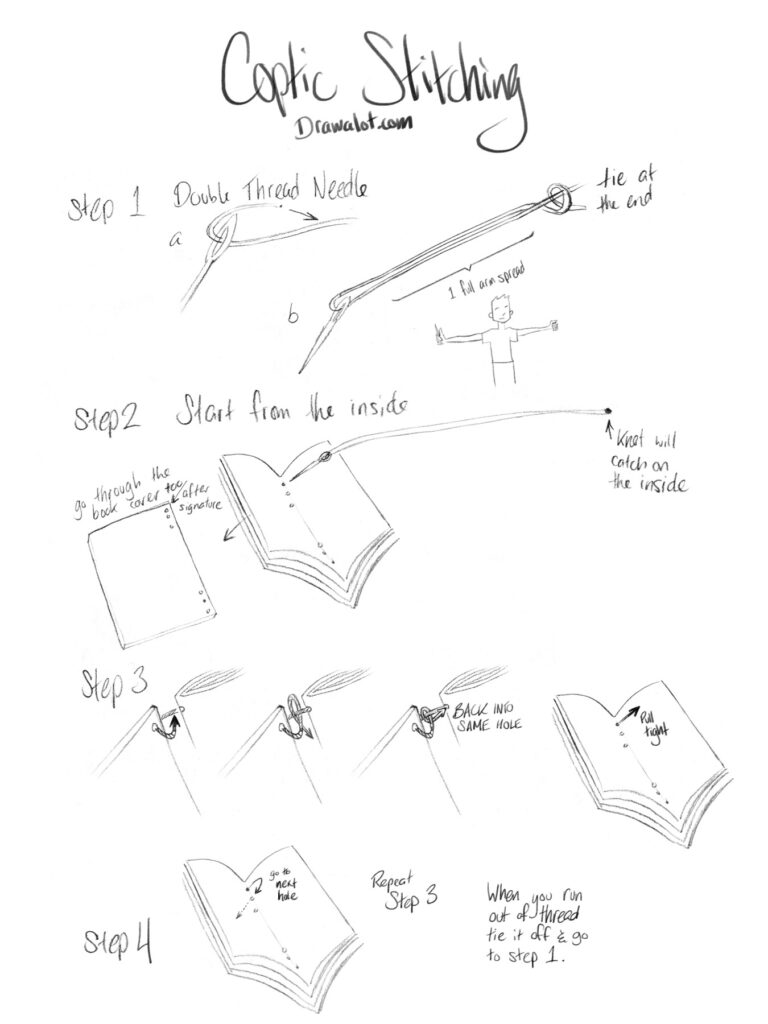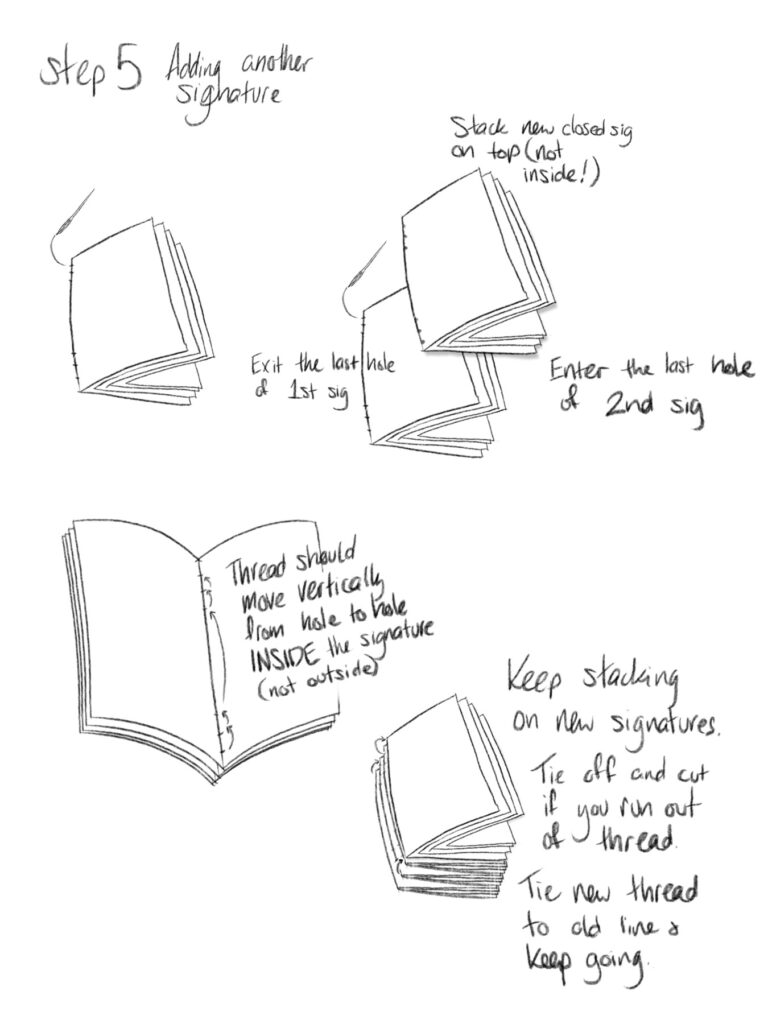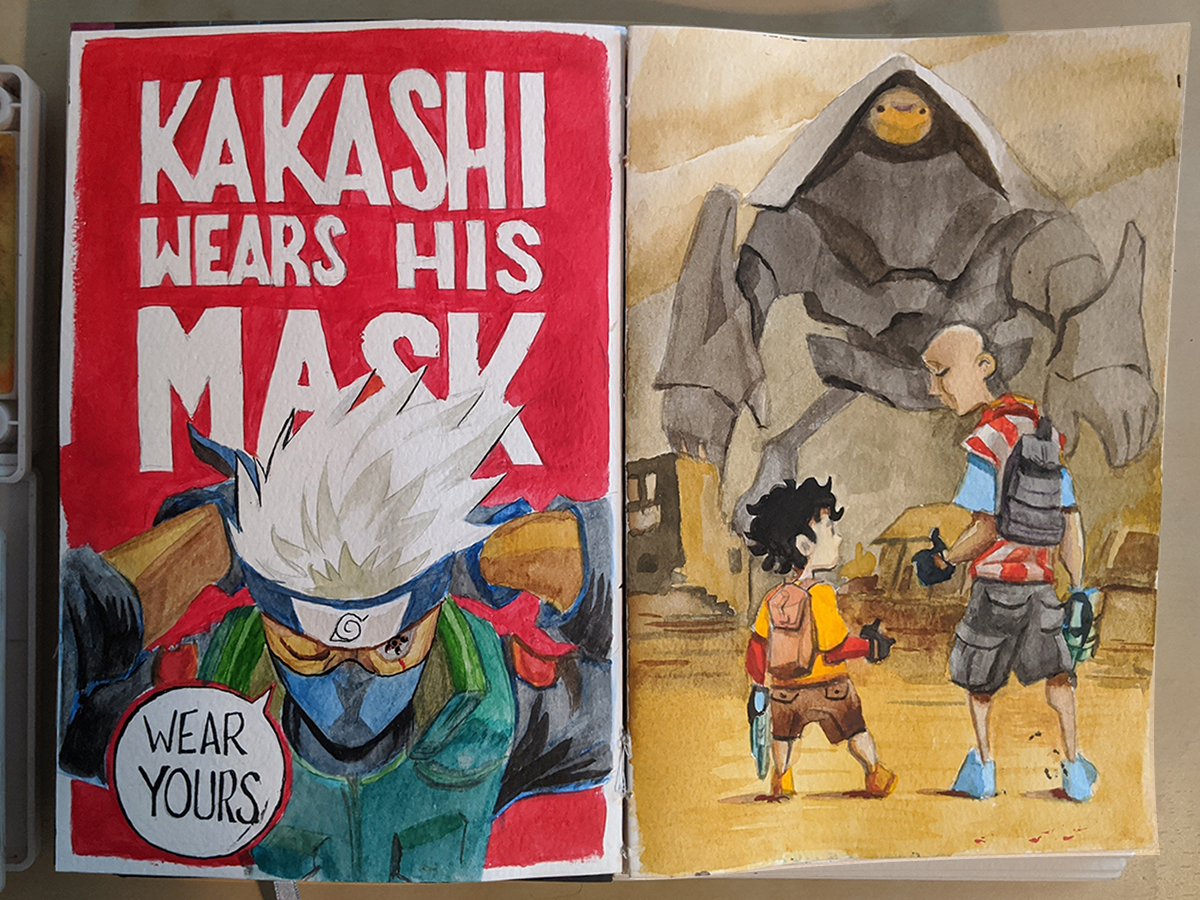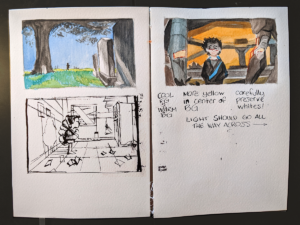Last week I handmade a coptic stitch sketchbook, and I’m having a blast filling it up. I was drawing and painting a lot before, and enjoying each piece of art, but I wasn’t quite sure what to do with them afterwards. There’s only so much room on my art board above my studio space. Now that I’m working in my sketchbook, I still get to enjoy every piece of art, but each piece becomes part of a greater whole. It’s like working on a big art project without the pressure of committing to a big art project.
Q: Why make the sketchbook by hand? Couldn’t you just buy a sketchpad already made?
Once you learn the sewing techniques it is remarkably easy to make a sketchbook while watching a film or a couple one-hour episodes of your favorite drama. I handmade mine from a $12 watercolor paper pad. You could make one from 50 sheets of regular computer paper, but then I wouldn’t really be able to paint, use markers, or black ink as it would show through the page.
Coptic Stitching basically allows you sew the pages together without binding. This means every single page or signature (a combination of four papers folded into each other) will open up and lay flat, and allows for easily drawing across the fold in the center. Every page can feel like a centerfold.
Here’s all you need
- 1 needle (bigger is better than too small)
- some thread (any kind is fine, but I use white cause it’s less visible)
- a thumbtack for making holes
- a sketchpad with a hard brown chipboard back (which you will cut in half and turn into the covers
- a blade or scissors
This or one of the many tutorials on book binding by Sea Lemon.
I wasn’t easily able to learn the sewing technique even after multiple viewings of the video tutorial, but my art students and I eventually figured it out after making some successful but poorly crafted attempts. My first book wasn’t pretty, but I was still very proud of it. So here’s a tutorial I drew to help you learn the technique. They’ll make more sense if you watch the above video first.


Working traditionally in a Sketch Journal will make you a better artist
For decades I have been drawing and painting almost exclusively on the computer. I use Photoshop and for a time I used an iPad Pro with the app Procreate. Digital painting allows me to get beautiful work done fast, and with a level of control that allows me to eventually make it look really professional. And most importantly, it allows me to make mistakes and correct mistakes easily.
The problem with digital art is that it is strangely hard to achieve a naturally harmonious look. There are almost no limits or constraints on what colors, values, and saturation you can put together. You almost have to make arbitrary rules to make your art look professional like, “I will only use colors near the center of the color picker,” or “I will only use reds and oranges,” or “I will only use the colors cherry-picked from my reference.”
Another problem with digital art is EVERYTHING is available, and the freedom is overwhelming. It’s analysis paralysis at its worst. Too many choices quickly exhausts your creative motivation.
Digital Art is Too Technical
My last complaint about digital art, and this is the biggest one, is digital art places way too much emphasis on the technical aspects of art. The first thing you see when you open a digital art app is all of the tool windows, options, layers, color palettes, and all the other junk that gets in the way of you freely drawing or painting. Creating art should feel liberating, slightly chaotic, and creative.
Technical tools are the necessary evil that often get in the way, although I must say there is some joy in discovering how to use one tool well. That’s one of the things I LOVE about traditional art. It limits your options to a few colors while using one tool at a time. You can use your body and turn the canvas much more comfortably allowing you to really wield your tool more naturally.
Be Bold
Traditional forces you to make bold choices because there are no layers or CNTRL + Z undos. It restricts your color palette. Unusual colors have to be mixed. The use of fewer colors and mixing those primary colors to create your secondary and tertiary colors naturally creates its own sense of harmony.
Mistakes for the most part won’t so easily just go away in traditional. That’s ok. Just roll with it. There is the danger that you might make the work worse instead of better, but danger raises the stakes and makes the game more rewarding.
Art for Art’s Sake is Good for the Soul
Like I said before, after decades of doing production art, in which the purpose of the illustration was to be part of a game, comic, website, or to promote some brand, or as research to improve my craft, it feels great to just draw and paint simply for the sake of drawing and painting. Due to the global pandemic I am not currently working full time and being isolated in my apartment for days at a time means I have a LOT more free time than usual.
So I am finally getting to paint and use watercolor and plein-air (outside observational) art–the kind I didn’t think I would be able to do until I retired. I am simply following my curiosities, and seeing if I can make beautiful images and discover some new techniques.
The Joy of Coloring Books
Some times I even do things the hard way like drawing big block letters and painting them in by hand–a process that would take 1 minute on the computer, but takes 1 hour to do with a paint brush and which comes out less perfectly even after all the extra effort. Why? Because I can listen to music, podcasts, or stories while mindlessly painting by number. It’s the same reason why children love coloring books, the reason why adult coloring books are the new zen trend, it’s the reason why people love to cook, to drive, play match 3 puzzle games, or do jigsaw puzzles. You lose track of time and you get to escape the existential problems of life for a little while. And then when you come to afterwards, you have something beautiful to show for it. Perhaps even something uniquely interesting that someone else might like to see. At the very least you can share your craft on social media. #SketchJournal
For anyone who would like some tips on drawing I have an online drawing course called, “How to Draw Like a Pro.” It contains the best drawing lessons from my animation degree and 8 years experience teaching a variety of age groups from teens to adults.

I’m also teaching live art classes for kids now on Outschool.

Need some fun self-paced projects for your kids to do? Sign up for our newsletter to receive a series of 5 lessons that will spark your tweenager’s curiosity, encourage their creativity, and tie them up just long enough for you to prepare the next meal!











